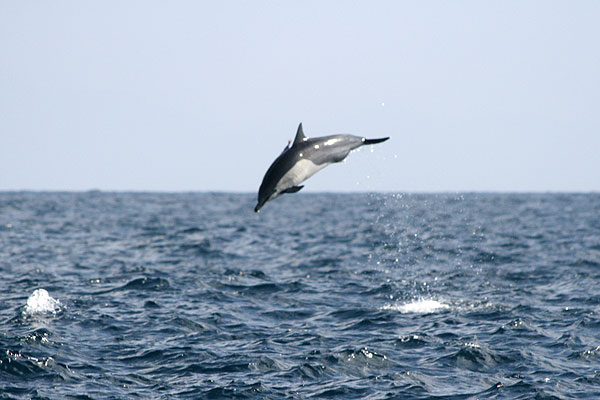Short-beaked and Long-beaked Common Dolphins

Find A Hotel in Los Cabos
Fantastic deals on hotels in Los Cabos with our booking partners. Amazing discounts on over 100 properties, instant reservation and user reviews/ratings to guarantee you get the hotel you want, when you want it. In many cases you PAY NOTHING now...check it out here!
Long-beaked common dolphins are relatively
small dolphins that can reach lengths of 6-8.5 ft (1.9-2.6 m) and weigh
160-500 lbs (80-235 kg). Males are slightly larger than females.
Long-beaked common dolphins have a rounded
melon, moderately long beak, and a sleek but robust body with a tall,
pointy, "falcate" dorsal fin located in the middle of the back. This
species can be identified by its distinct bright contrasting coloration
patterns. There is a dull yellow/tan thoracic panel between the dark
cape and white ventral patch forward of the dorsal fin. The bold
coloration forms a crisscrossing hourglass pattern below the dark
saddle, and a lighter gray area extends up to the tail stock. Narrow
dark stripes extend from the lower jaw to the flipper and from the eye
to the anal area. The coloration and patterns of young and juvenile
dolphins are muted and darker.
The short-beaked common dolphin is another species of common dolphin that
appears very similar to the long-beaked common dolphin. Both species are
within the same genus, Delphinus, and in some their distribution
overlaps in the waters around Los Cabos. The two species differ slightly
in physical size, features, coloration, and pattern and Short-beaked
common dolphins generally prefer deeper and cooler waters farther from
the coast.
Long-beaked common dolphins are usually found
in large social groups averaging from 100-500 animals, but have been
occasionally seen in larger herds of thousands of individuals,
particularly in the fall and early spring around Los Cabos. These large
schools are thought to consist of smaller sub-groups of 10-30 animals
that are possibly related or separated by age and/or sex.
These gregarious, energetic dolphins are
commonly seen swimming rapidly, "breaching", "porpoising", and
frequently engaging in other surface active behavior. They will often
approach boats to "bowride" for long periods of time.
Long-beaked common dolphins are capable of
diving to at least 900 ft (280 m) and holding their breath for up to 8
minutes to feed on prey. The majority of their diet consists of small
schooling fish (e.g., anchovies, hake, pilchards, and sardines), krill
and cephalopods (e.g., squid). Dolphin groups may work together to herd
schools of prey. This species has 47-67 pairs of small sharp conical
teeth in each jaw used for grasping prey.
Long-beaked common dolphins become sexually
mature at around 6.5 ft (2 m) in length (Jefferson et al. 2008).
Breeding usually takes place between the spring and autumn, followed by a
10-11 month gestation period. Females give birth to a single calf that
is about 2.5-3 ft (0.8-1 m) long and weighs about 20 lbs (10 kg), and
have an estimated calving interval of 1-3 years. These dolphins have an
estimated lifespan of approximately 40 years.